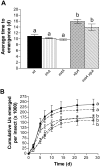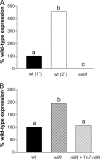Examination of Xenorhabdus nematophila lipases in pathogenic and mutualistic host interactions reveals a role for xlpA in nematode progeny production
- PMID: 19880652
- PMCID: PMC2798643
- DOI: 10.1128/AEM.01715-09
Examination of Xenorhabdus nematophila lipases in pathogenic and mutualistic host interactions reveals a role for xlpA in nematode progeny production
Abstract
Xenorhabdus nematophila is a gammaproteobacterium and broad-host-range insect pathogen. It is also a symbiont of Steinernema carpocapsae, the nematode vector that transports the bacterium between insect hosts. X. nematophila produces several secreted enzymes, including hemolysins, lipases, and proteases, which are thought to contribute to virulence or nutrient acquisition for the bacterium and its nematode host in vivo. X. nematophila has two lipase activities with distinct in vitro specificities for Tween and lecithin. The gene encoding the Tween-specific lipase, xlpA, has been identified and is not required for X. nematophila virulence in one insect host, the tobacco hornworm Manduca sexta. However, the gene encoding the lecithin-specific lipase activity is not currently known. Here, we identify X. nematophila estA, a gene encoding a putative lecithinase, and show that an estA mutant lacks in vitro lipase activity against lecithin but has wild-type virulence in Manduca sexta. X. nematophila secondary-form phenotypic variants have higher in vitro lecithinase activity and estA transcript levels than do primary-form variants, and estA transcription is negatively regulated by NilR, a repressor of nematode colonization factors. We establish a role for xlpA, but not estA, in supporting production of nematode progeny during growth in Galleria mellonella insects. Future research is aimed at characterizing the biological roles of estA and xlpA in other insect hosts.
Figures




Similar articles
-
High Levels of the Xenorhabdus nematophila Transcription Factor Lrp Promote Mutualism with the Steinernema carpocapsae Nematode Host.Appl Environ Microbiol. 2017 May 31;83(12):e00276-17. doi: 10.1128/AEM.00276-17. Print 2017 Jun 15. Appl Environ Microbiol. 2017. PMID: 28389546 Free PMC article.
-
The insect pathogenic bacterium Xenorhabdus innexi has attenuated virulence in multiple insect model hosts yet encodes a potent mosquitocidal toxin.BMC Genomics. 2017 Dec 1;18(1):927. doi: 10.1186/s12864-017-4311-4. BMC Genomics. 2017. PMID: 29191166 Free PMC article.
-
Xenorhabdus nematophila lrhA is necessary for motility, lipase activity, toxin expression, and virulence in Manduca sexta insects.J Bacteriol. 2008 Jul;190(14):4870-9. doi: 10.1128/JB.00358-08. Epub 2008 May 23. J Bacteriol. 2008. PMID: 18502863 Free PMC article.
-
They've got a ticket to ride: Xenorhabdus nematophila-Steinernema carpocapsae symbiosis.Curr Opin Microbiol. 2007 Jun;10(3):225-30. doi: 10.1016/j.mib.2007.05.006. Epub 2007 Jun 5. Curr Opin Microbiol. 2007. PMID: 17553732 Review.
-
Flagellar Regulation and Virulence in the Entomopathogenic Bacteria-Xenorhabdus nematophila and Photorhabdus luminescens.Curr Top Microbiol Immunol. 2017;402:39-51. doi: 10.1007/82_2016_53. Curr Top Microbiol Immunol. 2017. PMID: 28091933 Review.
Cited by
-
Comparison of Xenorhabdus bovienii bacterial strain genomes reveals diversity in symbiotic functions.BMC Genomics. 2015 Nov 2;16:889. doi: 10.1186/s12864-015-2000-8. BMC Genomics. 2015. PMID: 26525894 Free PMC article.
-
The Xenorhabdus nematophila LrhA transcriptional regulator modulates production of γ-keto-N-acyl amides with inhibitory activity against mutualistic host nematode egg hatching.Appl Environ Microbiol. 2024 Jul 24;90(7):e0052824. doi: 10.1128/aem.00528-24. Epub 2024 Jun 25. Appl Environ Microbiol. 2024. PMID: 38916293 Free PMC article.
-
FliZ is a global regulatory protein affecting the expression of flagellar and virulence genes in individual Xenorhabdus nematophila bacterial cells.PLoS Genet. 2013 Oct;9(10):e1003915. doi: 10.1371/journal.pgen.1003915. Epub 2013 Oct 31. PLoS Genet. 2013. PMID: 24204316 Free PMC article.
-
Improving the Yield of Xenocoumacin 1 Enabled by In Situ Product Removal.ACS Omega. 2020 Aug 3;5(32):20391-20398. doi: 10.1021/acsomega.0c02357. eCollection 2020 Aug 18. ACS Omega. 2020. PMID: 32832792 Free PMC article.
-
Xenorhabdus bovienii Strain Diversity Impacts Coevolution and Symbiotic Maintenance with Steinernema spp. Nematode Hosts.mBio. 2015 Jun 4;6(3):e00076. doi: 10.1128/mBio.00076-15. mBio. 2015. PMID: 26045536 Free PMC article.
References
-
- Abu Hatab, M., R. Gaugler, and R. U. Ehlers. 1998. Influence of culture method on Steinernema glaseri lipids. J. Parasitol. 84:215-221. - PubMed
-
- Bao, Y., D. P. Lies, H. Fu, and G. P. Roberts. 1991. An improved Tn7-based system for the single-copy insertion of cloned genes into chromosomes of gram-negative bacteria. Gene 109:167-168. - PubMed
-
- Beenakkers, A. M., D. J. Van der Horst, and W. J. Van Marrewijk. 1985. Insect lipids and lipoproteins, and their role in physiological processes. Prog. Lipid Res. 24:19-67. - PubMed
Publication types
MeSH terms
Substances
Grants and funding
LinkOut - more resources
Full Text Sources
Molecular Biology Databases

